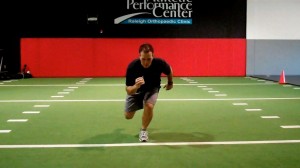Brian Schiff’s Blog
Injury Prevention, Sports Rehab & Performance Training Expert
Unfortunately, injuries cause more than pain and lost playing time for athletes. In many cases, an injury negatively impacts self-esteem and creates fear and anxiety. For competitive athletes, the injury often separates them from their familiar role and identity with respect to their teammates, coaches and peers.
It seems rather obvious that injured athletes would want to return to sport as soon as possible, right? Based on my clinical observations and experience, most athletes are motivated to return after their first injury. The more serious the injury (e.g. ACL tear, Achilles tendon rupture or UCL tear), the longer the road to get back. The speed and ease of the process is affected by the patient’s response to injury and surgery (coper vs. non-coper), degree of injury, skill of the surgeon, effectiveness of rehab, and patient compliance.
Much of the research done to date with fear of re-injury has centered on athletes undergoing ACL reconstruction. Over the last decade, methods for measuring kinesiophobia (fear of movement associated with sport/injury) such as the Tampa Scale of Kinesiophobia. I routinely use the TSK-11 with my athletes. In addition, the ACL-RSI is another tool for evaluating psychosocial readiness to return to sport. As sports medicine practitioners, we must pay attention to our clients’ fears and mental status.
Invariably, not all athletes want to return to sport. Factors that may hinder return to sport are:
- Chronic pain
- Fear of re-injury
- Fear or anxiety about long term pain, injury or future disability (such as osteoarthritis)
- Anxiety about not being able to return to their prior level of performance
Unfortunately, I see far too many patients following ACL reconstruction in my sports medicine practice. In any given month, I am rehabbing between 10 and 15 patients who have lost their season to this injury. Most of the time it is a non-contact mechanism of injury, often involving additional trauma to the collateral ligaments, menisci and/or cartilage within the joint.
Throughout my career, I have rehabbed several hundred athletes with ACL tears. It has always been an area of interest and passion for me as well as prevention. Blending my background in performance training with rehab, I have fostered through much trial and adjustment what seems to be a very effective approach to rehab and return to sport. Rehabbing higher level athletes is much like working on a high performance sports cars.
If you own a high performance vehicle, you would prefer to have it serviced at a dealership where the mechanics are experienced working on similar cars, yes? I feel the same care and application is relevant with ACL rehab. PT that is too aggressive or too conservative can impede progress and negatively impact peak performance.
I rehab far too many athletes under the age of 18 with ACL tears. In many cases, I am rehabbing some who have suffered multiple ACL ruptures before they graduate from high school. The burning question is why do so many clients suffer a graft failure or contralateral injury so so often?
Is it related to genetics? Is sports specialization to blame? Perhaps fatigue and limited recovery is a problem. I think the answer is multifactorial, but to be perfectly honest we as a profession have yet to truly arrive at a consensus as to when the “right time” to return to play is. Opinions vary widely based on the athlete, sport, native movement patterns, graft choice, additional injuries (ligament, cartilage or soft tissue) and the provider.
As a clinician dedicated to both prevention and the best rehab, I am always re-evlauating my own algorithm and rehab techniques, while looking for scientific rationale to direct my exercise selection and decision making processes. A recent paper by Webster and Feller in the November 2016 edition of AJSM looked at subsequent ACL injuries in subjects who underwent their primary ACLR under the age of 20 utilizing a hamstring autograft reconstruction procedure.
Why is it that athletes performing a movement they have done so many times suddenly tear their ACL? We have been studying ACL injury and prevention for many years now, and despite our best efforts, we have not made marked progress in preventing the number of ACL injuries. In addition to anatomical variants and perhaps some genetic predisposition, I feel that the earlier push for sports specialization in our society resulting in increased training/competition hours is a major factor.
The term ACL fatigue may or may not be familiar to you. But in essence, this theory would suggest that after a certain number of impacts/loading, the ACL becomes weakened and less resistant to strain. You could almost compare this to a pitcher who suffers an injury to his medial collateral ligament with too much throwing.
As someone who is consistently rehabbing athletes with ACL tears and screening athletes to assess injury risk, I am always interested in how we can keep people from suffering such a devastating non-contact injury. A recent article in the American Journal of Sports Medicine sought so assess ACL fatigue failure in relation to limited hip internal rotation with repeated pivot landings.
We already know that hip mobility is often an issue for our athletes. Researchers at the University of Michigan sought to determine the effect of limited range of femoral internal rotation, sex, femoral-ACL attachment angle, and tibial eminence volume on in vitro ACL fatigue life during repetitive simulated single leg pivot landings.
I just finished presenting at our our second ACL Symposium of the year at the Athletic Performance Center last Saturday. Rehabbing and training female athletes has been a passion of mine for some time. Over the years, I have also developed a love for research and reading it, particularly studies on the ACL.
In my practice, I have incorporated jump landing, single leg training and deceleration based training for some time. While we all know females are 3-8 times more likely to suffer an ACL injury than males, we have not isolated the exact reason why. Researchers have offered some clues such as: wider pelvis, narrow femoral notch, smaller ACL, ligament dominance, limb dominance, natural laxity (hormonal factors), wider Q angles, and faulty muscle firing patterns to name a few.
Many of the structural factors are beyond our control. So, as practitioners, we must focus on the training. Consider the following study just published in the August 2011 edition of the American Journal of Sports Medicine that basically reveals females develop peak valgus moments during deceleration during a drop landing maneuver, whereas males develop peak valgus forces during acceleration on the way back up:

Drop Landing
This article adds more evidence that females recruit and fire their muscles very differently than males. More importantly, it reiterates that we as coaches, therapists and S & C professionals need to be working on deceleration mechanics. I believe this starts with simple soft two legged drills such as:
- Small squat jump and holds
- Box drops and holds
- Forward line jump, stick and hold
- Lateral line jump, stick and hold
- 90 degree jump turn, stick and hold
In addition, one of my favorite drills is a single leg forward leap (hop) and stick working on deceleration. The athlete stands on the right leg and then pushes off forward landing on the left leg. Coaching the athlete to land softly on a bent hip and knee while avoiding valgus is important. I usually perform 2-3 sets of 5 reps on each side. Cueing with a mirror, auditory corrections and tactile cues are useful in encouraging proper form.

SL Stick (start)

SL Stick (finish)
It is important to keep in mind that the majority of non-contact ACL tears occur between 0 and 30 degrees of knee flexion. They also typically involve deceleration (landing, jump stop or change of direction), planting or cutting. For this reason, deceleration training must also involve programming for agility and change of direction.
On Saturday, I led the break-out session on deceleration training and covered a few key exercises I use with my athletes. These drills are layered on one another and the basic ones I begin with are:
- Stops – I have athletes accelerate out and then decelerate to a controlled two legged stop after 10-20 yards. Keep in mind allowing for a longer run will allow the athlete to gradually slow down, while decreasing the distance increases intensity and force on the knees. I coach breaking down with small “pitter patter” steps versus a sudden hard stop.
- 2 cone lateral shuffle stops – the athlete shuffles over 5-6 yards and then stops with good hip, knee and foot alignment working to keep the shoulders inside the knees (inside the box). I progress to multiple cone shuffles to increase intensity and maximize repetitive deceleration.
- Pro-agility drills – 3 cones are placed 5 yards apart and I combine linear and lateral movements between the cones layering #1 and #2 above in a continuous pattern to work on acceleration/deceleration combos and change of direction
- Y drill (4 cones) – the athlete runs forward to a cone 5-15 yards out and then performs a 45 degree cut left/right. The progression begins with directed and predictable movement and then advances to reactive cueing with auditory and visual cues.
- Arrow drill (4 cones) – The athlete runs 5-15 yards forward and then performs a 135 degree cut left/right and runs past the cone that serves as the bottom edge of the arrow head. This is much more demanding on the body (knee) and as such I only move to this after the Y drill has been mastered. In addition, I teach a hip turn (from Lee Taft) to reposition the hips and minimize torsion on the lower leg. I move from predictive to reactive agility as in the Y drill.
These exercises are a small sampling of my ACL prehab/rehab routine. I also include an enormous amount of single leg PRE’s and balance training as well. I believe the most important things we can currently do to reduce ACL risk in this population are:
- Screen our athletes to help identify risk (FMS, drop landing, dynamic strength,running/cutting analysis)
- Emphasize hamstring, gluteus medius and lateral rotator strengthening
- Teach landing mechanics and proper deceleration through neuromuscular exercise, biofeedback and repetitive cueing
- Refine proper cutting technique by teaching ideal angles and how to reposition the hips
- Empower coaches and athletes with simple yet effective body weight training routines that can be replicated on the field or court with the team
For now, the battle rages on. I hope you will join me in the quest to prevent these catastrophic injuries. I think as research evolves we will continue to see that the answer to promoting optimal stability at the knee will increasingly have more to do with addressing the hip and ankle. For now, we need to teach soft bent knee landing/cutting that shifts the body’s center of mass forward, while eliminating valgus loading as much as possible in the danger zone.




